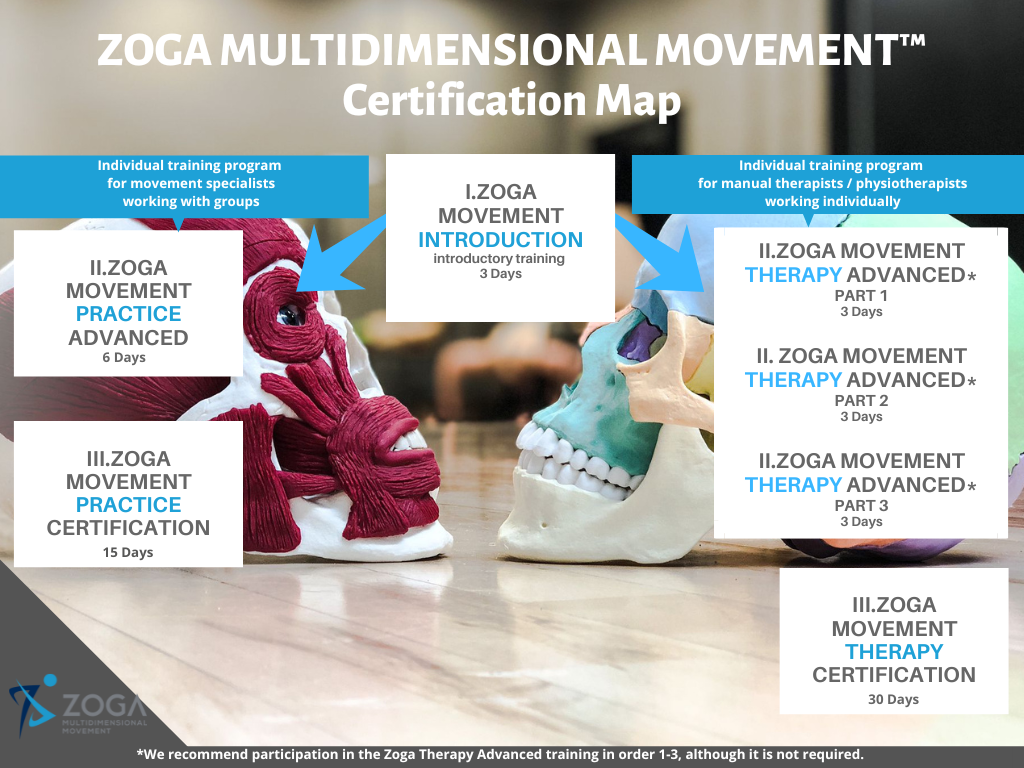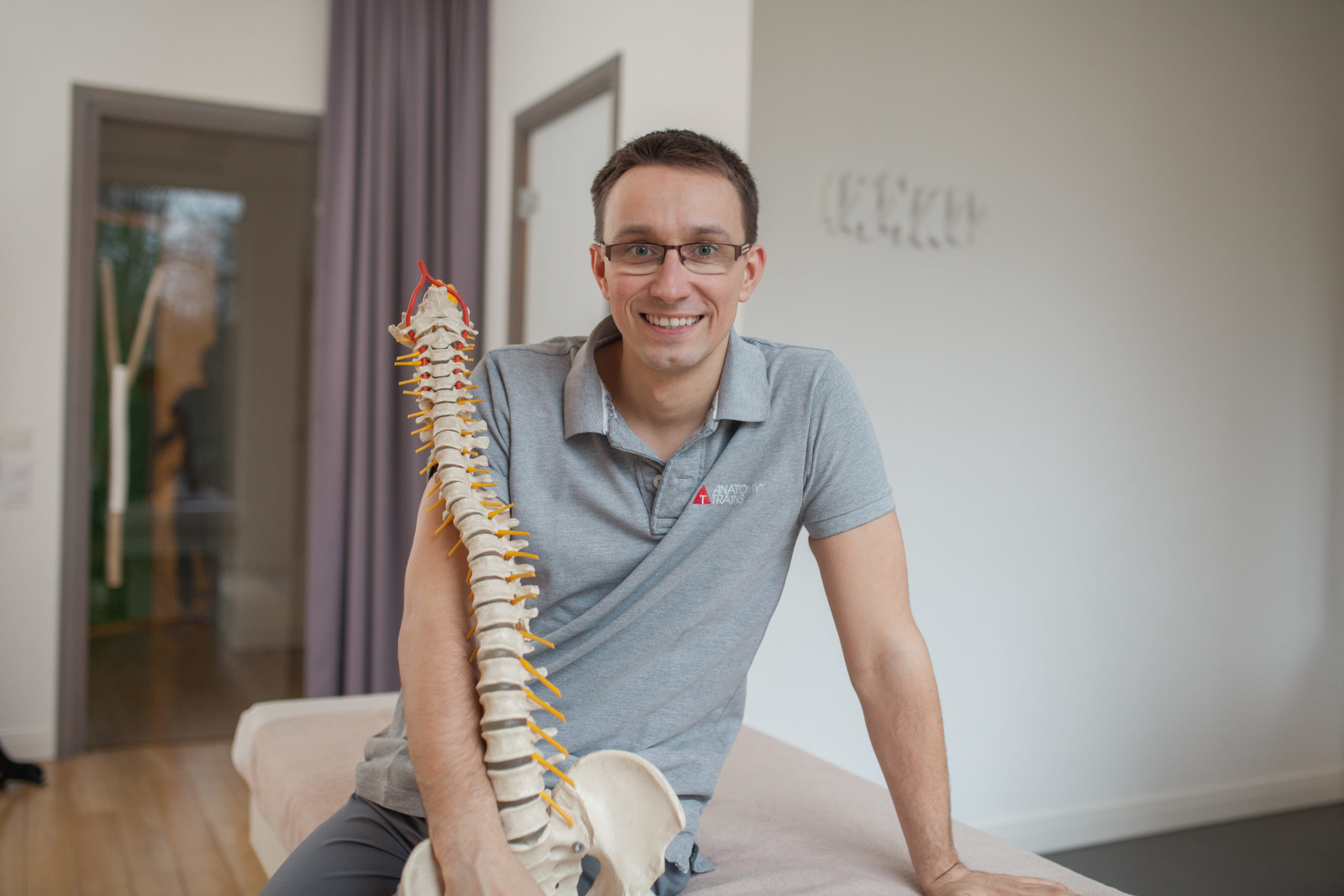Zoga Multidimensional Movement
About the method
Zoga is a movement concept for anyone who wants to achieve freedom and awareness of movement and posture in 4D. It tests all possible relationships of the body to gravity and creates many global and local movement vectors available in the body.
It uses the Anatomy Trains map to guide the process of biomechanical interventions around the fascial system tensegrity. Yoga Asanas are functional tests and postures that evoke different pulling vectors between different fascial layers. Zoga is designed to support and achieve the goals of Structural Integration and to create a permanent change of the pattern in the organization of the musculofascial system in the human body.
Zoga can take the form of:
- an individual journey through self-exploration of one’s own body (self-education process)
- experience group movement classes with a Certified Zoga Movement Practice Therapist
- or in one-on-one sessions with a Certified Zoga Movement Therapy Practitioner
Zoga Multidimensional Movement
Zoga is a movement concept for anyone who wants to achieve freedom and awareness of movement and posture in 4D. It tests all possible relationships of the body to gravity and creates many global and local movement vectors available in the body.
It uses the Anatomy Trains map to guide the process of biomechanical interventions around the tensegrity fascial system. Yoga Asanas are functional tests and postures that evoke different pulling vectors between different fascial layers. Zoga is designed to support and achieve the goals of Structural Integration and to create a lasting pattern change in the organization of the musculofascial system in the human body.
Zoga can take the form of:
- an individual journey through self-exploration of one’s own body (self-education process)
- experience group movement classes with a Zoga Movement Practitioner
- or in one-on-one sessions with a Certified Zoga Movement Therapist

ZOGA MOVEMENT INTRODUCTION
During this training, participants will learn the basic principles of working with the Zoga Movement method. They will be introduced to the concept of relative movement of tissues and its influence on chain reactions in joints, which determine the possibility of free movement. They will also learn the basics of postural analysis and biomechanical analysis of the body in motion. The next step will be to experience how to achieve changes in the spatial organization of the body in gravity through appropriately designed movement sequences and to restore more movement potential in their body and the patient’s body.
Additionally, trainees will learn effective manual and assistive movement techniques to help them achieve local and global changes in their patients’ biomechanical body systems.
We invite you to experience this transformation on yourself during the 3-day Zoga Movement Introduction course.
ZOGA MOVEMENT PRACTICE ADVANCED
A program designed for movement professionals who teach group classes. Students will learn all the principles of Zoga Movement based on structural integration, yoga and directional sliding of fascial layers. They will learn how to lead a 12-week program that will guide the group through a journey of self-exploration that will help them achieve a better relationship to gravity in posture and movement. The goal of this 12-week program is to help people reorganize their biotensegrity system, but also find better connections to themselves and their own bodies.
Zoga Movement Practice Certification Program
To become a certified Zoga Movement Practice Therapist…
Certification program for movement specialists working with groups. The certification program consists of 3 steps:
- Zoga Movement Introduction – 3 days (step one).
- Zoga Movement Practice Advanced – 6 days (step two).
- Zoga Movement Practice Certification Module – 15 days (step three).
After attending the Zoga Movement Introduction course (step one), the next step is a 6-day training focused on learning about Local Understanding and Global Interventions.
Zoga Movement Practice Advanced (step two) – 6 days. This program focuses on understanding 6 areas of the body. Each day will work on a different area. We will begin by learning about movement and gaining a spatial understanding of the anatomy of the entire body. Starting with the feet, we will explore movement between body segments, ending with balancing the movements of the head and neck. Students will also learn how to observe areas in need of movement intervention and how to make changes in those areas during classroom activities. We will explore the most common posture and movement patterns and then develop strategies to influence them.
Zoga Movement Practice Certification Module (Step Three) – 15 days. This 15-day module will focus on creating group class programs based on the 12-step principle built around Structural Integration strategies. It will teach you how to help clients achieve specific progress in both mobility and structural organization of the body. It will give you the opportunity to lead classes for people of all ages and fitness levels.
To become a certified Zoga Movement Practice Therapist you must successfully complete the certification class, which proceeds as follows:
- 5 days of classes & 2 days off
- 5 days of classes & 1 day off
- 5 days of classes
ZOGA MOVEMENT THERAPY ADVANCED
Zoga Movement Therapy Certification Program
This program is designed for therapists who want to work one-on-one with clients and who want to expand their understanding and use of movement in the therapeutic process. In this certification program, students will learn a 12-session therapeutic process that supports the goals of structural integration and gives clients the opportunity to better understanding themselves through movement. At the same time, it gives them the opportunity to regain freedom and lightness of movement and function in gravity.
Certification program for manual therapists/physiotherapists working individually:
- Zoga Movement Introduction – 3 days
- Zoga Movement Therapy Advanced Part 1 – 3 days
- Zoga Movement Therapy Advanced Part 2 – 3 days
- Zoga Movement Therapy Advanced Part 3 – 3 days
- Zoga Movement Therapy Certification Module – 30 days
Zoga Movement Therapy Certification Program
The training program begins with a Zoga Movement Introduction workshop (step one), followed by 3 advanced trainings (step two):
- Zoga Movement Therapy Advanced Part 1 – 3 days
“Feet, Legs and Pelvis “
During these 3 days, students will explore the anatomy and biomechanics of leg and pelvic movement. This includes group movement, functional and postural analysis, manual targeting and interventions. The training addresses the most common postural patterns and gives students the tools to explore and interact therapeutically to improve function in this area and improve its relationship to the rest of the body’s tensegrity system.
Zoga Movement Therapy Advanced Part 2 – 3 days
“Abdomen, Chest and Spine “
This part is designed to delve into the very complex world of breath, emotions, internal organs and vessels. Through movement, awareness exercises, touch, and breath, students will immerse themselves in the world of the “rhythms of life.” They will learn effective interventions that affect the ability to move in our “body cavities” and around the spine.
Zoga Movement Therapy Advanced Part 3 – 3 days
“Shoulders, Arms, Head and Neck “
During this final part, students will take a closer look at the relationships in movement and function between the head, neck and shoulders. Areas to focus on include the joint connections of C0, C1, C2, C3, C-T, clavicle, shoulder, forearm, and range of motion from wrist to fingers. We will learn about the movement capabilities of the upper extremities and shoulder girdle and how they affect the rest of the body.
Zoga Movement Therapy Certification Module (step three) – 30 days
This program is divided into 3 blocks (with 2 days off between each block).
During this certification component, students will learn a 12-session movement strategy process with manual and guided interventions through touch. There will be a teacher presentation, hands-on work between students, and therapy on outside models. It will teach participants to work with clients of all mobility levels and ages. This program will prepare you for a lifelong journey through exploration and constant challenge with evolving patterns of human structure and function. It will provide participants with the tools to create individualized programs in one-on-one sessions and group therapy.
The entire program lasts 40 days and is designed to support the structural integration process with more movement-oriented interventions that assist clients at various stages of change in the structural integration process. This therapeutic process is undoubtedly beneficial on its own, but the best results are achieved when combined with structural integration sessions.
Zoga Fascial Release in Pediatrics
This training presents methods of manual work. Soft tissue release techniques supported by the ability to make accurate structural and functional assessments are a core component of instruction in this training. A structural understanding of the relationships in the body helps to understand the relationships between many areas of the body.
These interrelationships in the body give us a picture of how stability determines proper function and how its disruption can lead to dysfunction. Once the relationships between the structures that create continuity are understood, their functioning can be examined and evaluated, and through balanced work, balance and ease of function can be restored to the course of these structures.
This method is very much in line with the principles of alignment used for example in NDT-Bobath therapy and is a very good preparation and complement to neurodevelopmental therapy. The course will focus on areas that are often challenging for therapists when working with children with neurological problems.
Classes include:
- 42 classroom hours of instruction.
- Detailed anatomy of the area – short and intensive presentations showing the most interesting views of anatomical structures supported by autopsy recordings, palpation anatomy, presented in an interesting and understandable way.
- Postural Analysis – common movement and postural consequences – how to see and read the intricacies of individual patterns.
- Musculoskeletal Release Techniques – each technique is demonstrated with understanding and a thorough “feel” for it so that you can use them immediately upon returning from training for your daily therapeutic work.
- Work with children with a variety of neurological problems using techniques learned.











